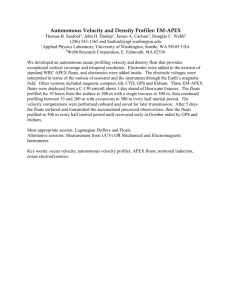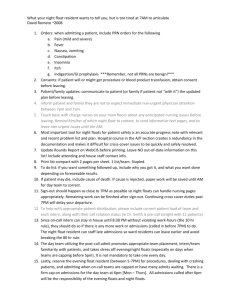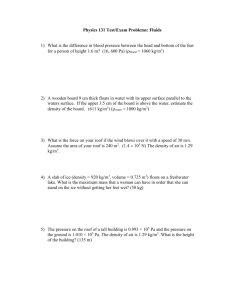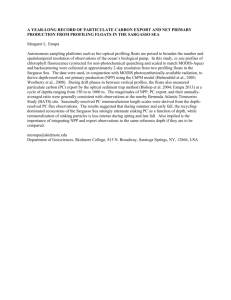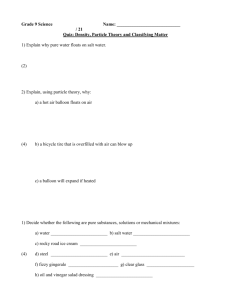Memo: Some advantages of SOFAR floats that move under their own
advertisement
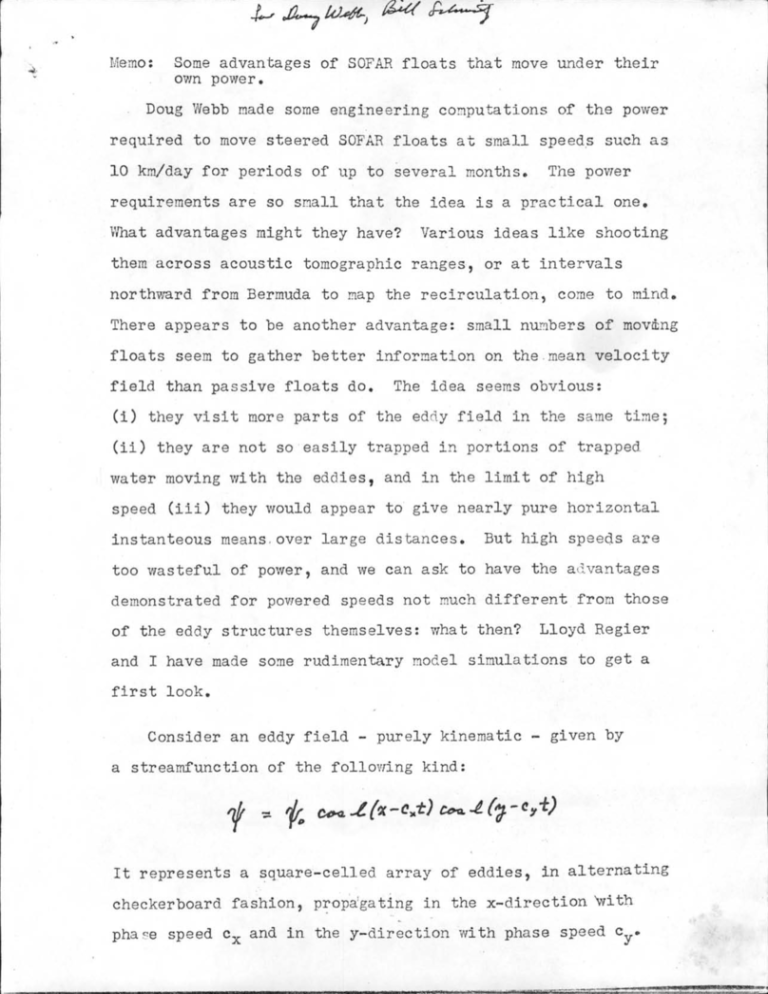
Memo:
Some advantages of SOFAR floats that move under their
own power.
Doug Webb made some engineering cosputations of the power
required to move steered SOFAR floats a t small speed,s such
10 km/day for periods of up to several months.
The power
requirements are so small that the idea is a practical one.
Vfuat advantages might they have?
Various ideas like shooting
them across acoustic tomographic ranges, or at intervals
northvmrd from Bermuda to map the recirculation, come to mind.
There appears to be another advantage: small nQ~bers of movmng
floats seem to gather better information on the.mean velocity
field than passive floats do.
The idea seems obvious:
(i) they visit more parts of the eddy field in the same ti~e;
(ii) they are not so easily trapped in portions of trapped
water moving with the eddies, and in the limit of high
speed (iii) they would appear to give nearly pure horizontal
instanteous means. over large distances.
But high speeqs are
too wasteful of power, and we can ask to have the advantages
demonstrated for powered speeds not much different from those
of the eddy structures themselves: what then?
Lloyd Regier
and I have made so~e rudimen~~ry model simulations to get a
first look.
Consider an eddy field - purely kinematic - given by
a streamfunction of the following kind:
It represents a ~quare-celled array of eddies, in alternating
checkerboard fashion, p~op~gating in the x-direction with
..
pha~e speed
Cx
and in the y-direction with phase speed cy•
2
Figure I shows a sketch of the eddy field at time t ~ 0,
and also shows the trajectories of some floats that one
would get were both phase velocity components zero. In this
particular example the 'wavelength ( twice the "eddy size")
is 200 km, and the amplitude of the current is 20 km/day.
Some days are marked on the trajectories.
Floats simply
go round and round.
However, if there is a non-vanishing phase velocity
things are very different.
Floats can get trapped and move
with the phase velocity; others can be handed on from one eddy
to another, and move in the opposite direction.
Figure 2
x -6 km/day,
Depending on
shows some sample float trajectories computed with
and amplitude of the current at 30 km/day.
C
where the floats are inserted, they can move for long distances
eit!~er ea::-tor west - and they execute very complicated
trajectories.
Indeed it is qui te impossible to guess at the na ture of the
velocity field from the inspection: the floats move in
widely different directions, the curlicues are of different
sizes, trajectories cross, etc.
The trajectories are cOr.1putedfro~l1the forrmla:
a.
•
-Q.
In Figure 2, uo and
o arc taken both as zero, otherTIise
V
they can be interpreted as the mean velocity TIithin the whole
field ( or the time mean taken in the Eulerian sense at any
point).
- 3 Transforming the coordinate system to one moving with
the phase veloci ty it is pos sible to.see th;tt!'oughly t::,ro-thirds
of the water is trapped in closed eddies moving westward, and
one third moves eastward meandering between the eddies. These
proportions of course vary 'with the ratio
a/cx• Indilfridual
floats remain "stuck" in' certain regimes, and adequate
sampling
for determination of the var:,ous means would require very large
nQmbers of floats - long times do not help for regular systems
of this kind where trapping in one regime or the other is
perpetual.
More complicated randomised eddy fields might
behave differently.
One way to get better sa~pling is to power the float and
steer it through the water at some fixed velocity uf,vf relative
to the water.
Under these circumstances the trajectory is
computed using uo:= U + uf,
vo;
V
+ vf, where the bars
denote a large-scale, long period mean over the whole field
that is to be determined by measurement.
In principle, if
we make uf,vf large enough there will be no trapped floats,
althought there will be trapped water particles. Un60rtunately
this requires float relative velocities comparable to the
amplitude a, and this could mean required float speeds of some
20 km/day for complete avoidance of float trapping. But some
improvements of estimates of uo,vo 'to be obtained from
movement of clusters of floats might be obtained with relatively
small valu~s of Uf,Vfe
Th8refore we make some simulation runs of floats with
various values of uf'vf, for the case depicted in Figure 1.
a
20km/day,
cx
- 5 km/day, ~imensions of instanteo~s
eddy 100 km ( half wavelength).
_.,-" ~..-
f.
~ --.r'
.:J
~
. i
~f':-i
:i
.--l~_--iI
L __" I
-J.
_
I
I
. -+-.-
".
,.-
I
!
I
,....
I
I
I,
._1- __
.f--'
,,'
I
I
"I
"
_
!
_L_ ..
,
_
I
I.-I
!
i
i
J': ..;.
.~'.
',:r.'~.,
: .-:1 '
.I
h.::-~.
"7---
Q
-..
C>
,-
'ri" ~::-:-r::-~-'1-.. ;:~:'!
.•"..,.1-;
::! .
-.
r4-;:!j~r~:i:~1. .
i
.__.~---~._-_
..- .._. ,.
~
._--.,-.
...
.•.
'I
""'?-
(
+
i
;:1:
l
j
.,-~
-,-
<::I
"~=I......
.'
~:'l:i
.....•
,.! lei f'
~~:;.:-.----t-=r~::r~~:i
,.{-:;.:--
':'
' :<I '::r':'.1
,.
':~.:~~:...:::t-
-
.
c:>
.~t~-~;~l-~10~f;~~~-:-I--"-~
~[:
---.r ----,..
----_._---~
..t :-~;,.:.
.
,
- --i~;..: . '-~'I'
- : -1-: .: f . i -;~:._-::-' -'1
•
I
I
;
I ....
i
,
~
'
-
-
i, ,- >
-
I
•
-
- -
f
.
.1
."
'r'-.
'" -
i : .
-;...--
-,
---j
.
!
.1
.j
I
Simulation runs:
U and V are the drift velocity
of the center of mass of a cluster of floats
corrected for uf' vf, over the entire nUMber
of days of drif~.
Simulation
No. floats
Float days
vf
U
A
6
120
30
0.92
0.66
B
6
i20
200
0.18
0.02
c
6
.120
0
-1.76
-0.85
D
6
120
10
E
1
200
10.
0.50
F
1
180
10
0.06 -1.43
G
4
400
10
0 .•
01
-1.0lf-
H
1
240
10
1.50
0.48
Gf
1
100
10
-4.68
-0.22
I
7
560
10
0.08
0.50
V
-2.,29 2.98
0.38
The plans of the initial deployment of these
floats are given in Figure 3.
In all runs except F and G the float direction was
hel~ constant. In these runs direction was changed at
fixed days. Thus in run F, the i~itial value of vf was
positive; at 30 days reversed; at 60 days reversed again, and
so on. The integral of vf over the 18Odtotal run was zero.
Thus in this run the floaL was steered across the sa~e region
more or less, six times.
In run H, a similar type repeated scanning was done, but
according to the schedule:
Statring Day
0
30
60
120
150
180
210
240
uf
vf
0
10
0 -10
0
-10
0
10
10
0
0
-10
0 -10
10
0
I
,'-
'
•••..•......
,':
,
--;"'Plans:;'or--.Si"mulatHm'- initial",pos
i-:
i
,.
'. . "
I
J
iti-ons-'-'"
l'
;
,
1tJ';
:
•
L
.
...
oj
I
. ;-'!.
.,.
-
I
If'
\.
Sh.
---,-'"
I' ;
:
,
:
i
, -i-!
_.~...
1(:f~
j
'--->'"I'~'
,-
l>
--:>- /f..
0--1--'-'"
_..
5'0
E
_ •.•...••
_.•
....-t..~.
,
---
~
".
-I
A:, B)'C) D
••• '.
-.....-..._ ... --- ..
-..
--'-
,--
.~
i~
•..
, ~
.
...
>'J"'-
F, H
I,
••
J
..
-j
l~,
"
I
'
\,.
I
tt,-t .•"'...( :~, •..)' ...;i.•.••..:
~i-------_.-.----,
,
12,.(;
til
1
46
({t-
9
~
.-~
r.;.
~~
1
;,.9
~'
!,
':
"
~--
,
!
f
I
I
:
J
!
i
•
.--,,
,,
' •• ~
••
I
••
!.. •• J
i
'
,k
I
(!(i .•'<t~'
+
~
j
.,
j ,
---"-----".--",''''''''-
I
'
'r--"
, I
I',
!
l'
':"'r
•..
,.+-l
.t
..;
"t_
!
.!
\
._T~j::::<.
-+
i
I
_j.1
....
.•..
1
.
•••
2()
J---
i
,. '._~.....~.-
/,
'~
,- i'
,
.;
.
i-!
,
I
I
;
\ "
1
:
:
'1
•
:
,,,'
i
_
';"!
!~O~E;; ;.:In :runs ,F ~arid iH the 'value of ;Uf, vf ,was chaqged :~everal
I:
;. ~,;. : !.
L 1.:' .1',by 'i.n~ernal '.f<~oa:t program dl~ring the, run,
!;
!-i'. l:'j. "
.-Jtj:.:'.L~.,~:.:....l. ......;
.:jj :.
.
times
.
:
I
LJ '..~_:.~j~~~1~tL~L.i..t
~~I~
~
1_~~.L.~.. _... :_
.~:
Comments:
Obviouslyw~ need to do many more runs: but something
emerges:
Compare for example the U and V for cases Band
C.
Case C has passive floats.
From the total 120 float days
south( 6 floats each 20 days ) we seem to find a/westward mean
drift of almost 2 km/day •. There is actually a ~
velocity eve~ywhere in the field.
mean Eulerian
Case B with the rapidly
moving float ( 200 km/day) gives a much better estimate of
zero.
Powered floats can be trapped ( see the trapped
float in G').
The cluster I of 7 floats moving northward
for 80 days each, moved about 800 km north of the original
deployment - much like a line launched near Bermuda would
go across the recirculation region. It gives a pretty acceptable
estimate of the mean.
We will make a lot more runs, of clusters of 20-40
floats each, and try to make the case for the advantages
of powered floats more definitely.
Lloyd Regier and Henry Sto~mel
April 20, 1978
17- s-.
~
"&F!:' .:--""'f-} "'""'l'
~
>b -k
r.
